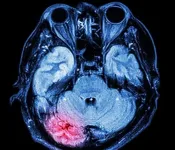(Press-News.org) Accumulation of water in the lungs (lungcongestion) is a common condition in hemodialysis patients, particularly in those at high cardiovascular risk, like those presenting coronary artery disease and/or heart failure. This alteration can be detected in an X-ray image, but cannot be heard easily with a stethoscope. When the congestion becomes so severe that fluid floods the alveoli ('alveolar pulmonary edema'), the sound of rattling breathing can be heard (and without a stethoscope at a later stage). Then, at the latest, pulmonary gas exchange is severely impaired, and the patients experience shortness of breath or even fear of death.
For hemodialysis patients, especially, lung congestion is a strong risk factor for mortality. Between dialysis sessions, all fluid which patients introduce is retained. Severe overhydration may ensue and this can then lead to heart decompensation. The degree of lung congestion can be assessed by ultrasound examination (sonography), and this may be used to adjust fluid removal during hemodialysis and drug therapies.
An international, multicenter study in 363 patients investigated whether such an ultrasound-based approach improves patient outcomes [1]. The primary endpoints were mortality, heart attack and decompensated heart failure. This strategy was compared with standard care in hemodialysis patients with a high cardiovascular risk.
The ultrasound examinations were carried out by the nephrologists themselves after brief instruction via a web platform. Sonographic control examinations were also performed periodically by cardiologists (blinded, i.e. without prior knowledge of the treatment that patients were receiving). The measurement parameters were B-lines in the ultrasound image, indicating fluid accumulation in lung tissue. The target for hemodialysis management was less than 15 sonographic B-lines.
In the sonography group (n=183), the number of B-lines decreased from 15 to nine from the beginning to the end of the study; in the control group (n=180), however, the number increased from 16 to 30 (p=0.002). In the sonography group, 117 patients (78%) reached the target value ( END
Lung sonography is an useful guide to lung decongestion in HD patients at high CV risk
Dangerous lung congestion or overhydration can be detected relatively easily in dialysis patients by means of ultrasound examinations and the application of this technique is useful to safely guide lung decongestion.
2021-06-07
ELSE PRESS RELEASES FROM THIS DATE:
A mechanism through which 'good' viruses kill 'bad' bacteria and block their reproduction
2021-06-07
The battle against antibiotic-resistant bacteria: A new study at Tel Aviv University revealed a mechanism through which "good" viruses can attack the systems of "bad" bacteria, destroy them and block their reproduction. The researchers demonstrated that the "good" virus (bacteriophage) is able to block the replication mechanism of the bacteria's DNA without damaging its own, and note that the ability to distinguish between oneself and others is crucial in nature. They explain that their discovery reveals one more fascinating aspect of the mutual relations between bacteria and bacteriophages and may ...
A targeted treatment for IgA nephropathy at last?
2021-06-07
IgA nephropathy (IgAN) is a chronic kidney disease occurring in young adults and is one of the most common reasons for kidney transplantation in this age group. IgAN is the most common form of glomerulonephritis (GN), i.e., immunologically induced inflammation of the renal glomeruli. It is characterized by glomerular deposition of immune complexes containing immunoglobulin A (IgA), and by a complex inflammatory response and progressive loss of kidney function. For many decades, IgAN has therefore been treated with anti-inflammatory or strong immunosuppressive agents. ...
Wider applications for Vortex Fluidic Device
2021-06-07
Wider clean chemistry applications of the extraordinary Vortex Fluidic Device - invented by Flinders University's Professor Colin Raston - are likely in the wake of new research that has been published outlining the seemingly endless possible uses.
The defining paper on understanding fluid flow in the Vortex Fluidic Device has just been comprehensively explained in an article published in Nanoscale Advances (DOI: 10.1039/D1NA00195G).
This took more than 100,000 experiments to work out - and Professor Raston hopes this publication will encourage more researchers to embrace the VFD and explore yet more innovative applications for this ingenious device.
"How fluid flows is one of the grand challenges of science," says Professor Raston. "What we have been ...
New drug to halt dementia after multiple head injuries
2021-06-07
A world-first international study led by the University of South Australia has identified a new drug to stop athletes developing dementia after sustaining repeated head injuries in their career.
The link between concussion and neurogenerative diseases is well established, but new research findings could halt the progression of chronic traumatic encephalopathy (CTE) in sportspeople who sustain repeated blows to the head.
CTE is a progressive and fatal brain disease associated with the accumulation of a protein known as hyperphosphorylated tau which affects cognition and behaviour.
In a paper published in Scientific Reports, ...
Study supports gene therapy as a promising treatment for soft bone disease
2021-06-07
LA JOLLA, CALIF. - June 7, 2021 - A preclinical study led by scientists at Sanford Burnham Prebys has established that AAV8-TNAP-D10--a gene therapy that replaces a key enzyme found in bone--may be a safe and effective single-dose treatment for hypophosphatasia (HPP). The study, published in the Journal of Bone and Mineral Research and performed in a murine model of the disease, further supports advancing the therapy toward human clinical trials.
"This is the most promising gene therapy study to date demonstrating a successful increase in life span, and improvement ...
Monash researchers make fundamental advance in understanding T cell immunity
2021-06-07
Monash University researchers have provided a fundamental advance regarding how T cells become activated when encountering pathogens such as viruses.
The recent study published in Science, co-led by Professor Nicole La Gruta, Professor Jamie Rossjohn and Professor Stephanie Gras with first author Dr Pirooz Zareie from the Monash Biomedicine Discovery Institute, have found that T Cells need to recognise pathogens in a particular orientation in order to receive a strong activating signal.
T cells play a key role in the immune system by eliminating invading pathogens, such as viruses, and it is crucial to understand ...
How coronavirus aerosols travel through our lungs
2021-06-07
When we inhale isolated coronavirus particles, more than 65% reach the deepest region of our lungs where damage to cells can lead to low blood oxygen levels, new research has discovered, and more of these aerosols reach the right lung than the left.
Lead author of the study Dr Saidul Islam, from the University of Technology Sydney, said while previous research has revealed how virus aerosols travel through the upper airways including the nose, mouth and throat - this study was the first to examine how they flow through the lower lungs.
"Our ...
Axions could be the fossil of the universe researchers have been waiting for
2021-06-07
Finding the hypothetical particle axion could mean finding out for the first time what happened in the Universe a second after the Big Bang, suggests a new study published in Physical Review D on June 7.
How far back into the Universe's past can we look today? In the electromagnetic spectrum, observations of the Cosmic Microwave Background -- commonly referred to as the CMB -- allow us to see back almost 14 billion years to when the Universe cooled sufficiently for protons and electrons to combine and form neutral hydrogen. The CMB has taught us an inordinate amount about the evolution of the cosmos, but photons in the CMB were released 400,000 years after the Big Bang making it extremely challenging to learn about the history of ...
Measuring gene expression changes over time may help predict T1D diabetes progression
2021-06-07
TAMPA, Fla. (June 4, 2021) — Type 1 diabetes (T1D) is an autoimmune disease in which a misdirected immune system gradually destroys healthy pancreatic islet β cells, resulting in a lack of insulin. The exact cause of T1D remains unknown. However, β cell-reactive autoantibodies can be detected in circulating blood months to years before diagnosis, raising the possibility of intervening to stop or delay T1D before children develop the disease.
Monitoring the number, type, and concentration of autoantibodies appearing in the blood can help predict the long-term risk of progression from autoimmunity to symptomatic T1D.
Now new findings suggest that measuring how patterns ...
Computers can now predict our preferences directly from our brain
2021-06-07
A research team from the University of Copenhagen and University of Helsinki demonstrates it is possible to predict individual preferences based on how a person's brain responses match up to others. This could potentially be used to provide individually-tailored media content -- and perhaps even to enlighten us about ourselves.
We have become accustomed to online algorithms trying to guess our preferences for everything from movies and music to news and shopping. This is based not only on what we have searched for, looked at, or listened to, but also on how these activities compare to others. Collaborative filtering, as the technique is called, uses hidden ...
LAST 30 PRESS RELEASES:
Do our body clocks influence our risk of dementia?
Anthropologists offer new evidence of bipedalism in long-debated fossil discovery
Safer receipt paper from wood
Dosage-sensitive genes suggest no whole-genome duplications in ancestral angiosperm
First ancient human herpesvirus genomes document their deep history with humans
Why Some Bacteria Survive Antibiotics and How to Stop Them - New study reveals that bacteria can survive antibiotic treatment through two fundamentally different “shutdown modes”
UCLA study links scar healing to dangerous placenta condition
CHANGE-seq-BE finds off-target changes in the genome from base editors
The Journal of Nuclear Medicine Ahead-of-Print Tip Sheet: January 2, 2026
Delayed or absent first dose of measles, mumps, and rubella vaccination
Trends in US preterm birth rates by household income and race and ethnicity
Study identifies potential biomarker linked to progression and brain inflammation in multiple sclerosis
Many mothers in Norway do not show up for postnatal check-ups
Researchers want to find out why quick clay is so unstable
Superradiant spins show teamwork at the quantum scale
Cleveland Clinic Research links tumor bacteria to immunotherapy resistance in head and neck cancer
First Editorial of 2026: Resisting AI slop
Joint ground- and space-based observations reveal Saturn-mass rogue planet
Inheritable genetic variant offers protection against blood cancer risk and progression
Pigs settled Pacific islands alongside early human voyagers
A Coral reef’s daily pulse reshapes microbes in surrounding waters
EAST Tokamak experiments exceed plasma density limit, offering new approach to fusion ignition
Groundbreaking discovery reveals Africa’s oldest cremation pyre and complex ritual practices
First breathing ‘lung-on-chip’ developed using genetically identical cells
How people moved pigs across the Pacific
Interaction of climate change and human activity and its impact on plant diversity in Qinghai-Tibet plateau
From addressing uncertainty to national strategy: an interpretation of Professor Lim Siong Guan’s views
Clinical trials on AI language model use in digestive healthcare
Scientists improve robotic visual–inertial trajectory localization accuracy using cross-modal interaction and selection techniques
Correlation between cancer cachexia and immune-related adverse events in HCC
[Press-News.org] Lung sonography is an useful guide to lung decongestion in HD patients at high CV riskDangerous lung congestion or overhydration can be detected relatively easily in dialysis patients by means of ultrasound examinations and the application of this technique is useful to safely guide lung decongestion.





